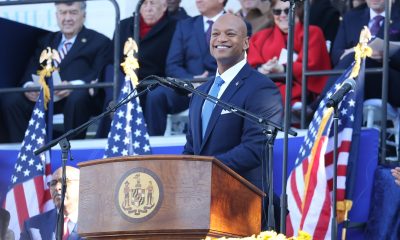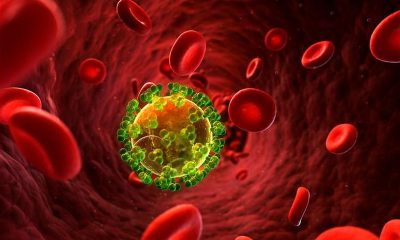Local
Dozens testify at Md. House hearing on marriage bill
Backers fear needed support may be eroding; referendum threat looms
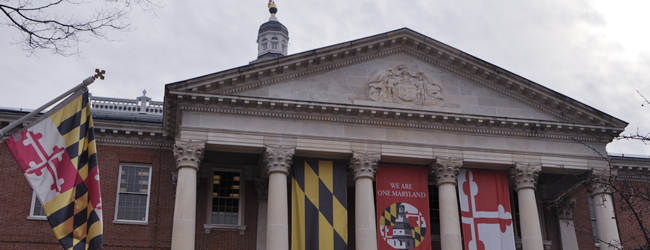
Dozens of witnesses testified for and against a same-sex marriage bill before a committee of the Maryland House of Delegates in Annapolis on Friday as the bill’s sponsors cautioned supporters not to become complacent.
Among the first to testify for the bill were the five lesbian members and one gay male member of the House of Delegates, who gave personal accounts of how they and their partners are considered “strangers” under the current Maryland law that bars same-sex couples from marrying.
Many of the same-sex marriage bill’s opponents, while testifying against that measure, testified in favor of a separate bill under consideration at the hearing that was introduced by Del. Don Dwyer (R-Anne Arundel County). Dwyer’s bill calls for a state constitutional amendment banning same-sex marriage.
The Civil Marriage Protection Act, which would legalize marriage for gay and lesbian couples, was approved one day earlier in the Maryland Senate by a vote of 25-21, prompting LGBT activists to celebrate what they called a historic victory.
But officials with the statewide LGBT advocacy group Equality Maryland expressed concern that an expected vote on the bill in the House of Delegates within the next two weeks appears much closer than originally expected.
Backers said that as of this week, the number of delegates who have publicly declared their support for the bill was just short of the 71 votes needed in the 141-member House.
“There’s an effort to derail this bill like none I’ve seen before,” said gay State Sen. Richard Madaleno (D-Montgomery County), the author and one of the lead sponsors of the marriage equality bill in the Senate.
In a telephone news briefing on Friday, Madaleno said the mainstream media have repeatedly reported an earlier assumption that support for the bill was greater in the House than in the Senate, and approval of the measure in the Senate guaranteed its passage in the House.
With opponents, including the Maryland Catholic Conference and the New Jersey-based National Organization for Marriage, applying enormous pressure on wavering delegates, Madaleno and Equality Maryland officials said support in the House might be in jeopardy.
A warning signal that support in the House could diminish surfaced earlier in the week when Del. Melvin Stukes (D-Baltimore City), a co-sponsor of the marriage bill for the past four years, withdrew his sponsorship.
Stukes told the Baltimore Sun he thought the bill would have given same-sex couples the right to obtain civil unions rather than marriage. Once he realized the measure would allow gays to marry he determined he made a mistake, he told the Sun.
“I’m very sorry that I got on the bill,” he said.
Activists said privately that they were baffled over Stukes’ change of heart on the bill because he represents a progressive-leaning district in Baltimore where the majority of residents would not object to his support for allowing gays to marry.
Del. Heather Mizeur (D-Montgomery County), one of the House’s five lesbian members, said concern over possible erosion of support among delegates prompted supporters to scrap an earlier strategy calling for bringing the bill up for a vote at the very end of the House of Delegates session in April.
Doing that would shorten the time opponents have for gathering petition signatures needed to place the bill before voters in a referendum, making it more difficult to pull off a referendum.
Under Maryland’s referendum law, the clock begins for obtaining petitions when a bill is passed by both houses and the governor signs it. The state constitution sets the deadline for turning in the required number of petition signatures — 3 percent of the registered voters in the state — by June 1 following the adjournment of the legislature, which usually takes place at the end of April.
Thus by passing the marriage bill in the House in early March, as supporters now hope to do, opponents could get more than a month of additional time to obtain the petition signatures than if the bill passed at the end of the session in late April. Gov. Martin O’Malley has said he would sign the bill if it reaches him.
If opponents succeed in gathering the required number of valid petition signatures, the bill is put on hold. It would not become law unless voters defeat the referendum question submitted by opponents, which would call for defeating the bill and defining marriage in the state as a union only between a man and a woman.
“Momentum is important,” said Mizeur, in discussing the decision to put the marriage bill on a fast track in the House. “If we had the luxury of 83 public commitments to voting on this instead of 69 of the 71 that we need, sure, we could wait. But at this stage of the game, we need to just get it passed and worry about the referendum later.”
Backers of the same-sex marriage bill also expressed concern about an e-mail that Dwyer sent to churches and religious groups that included an attached pamphlet called “What-same-sex ‘marriage’ has done to Massachusetts.” The pamphlet describes a series of school-related programs and discussions for elementary and high school students touching on same-sex marriage that LGBT activists in Massachusetts say are distorted and sensationalized to draw opposition to same-sex marriage.
A second pamphlet that Dwyer attached to his e-mail, called “Little Black Book: V 2.0 Queer in the 21st Century,” was prepared by an AIDS group and funded in part by the Massachusetts Department of Heath as a safe-sex and “coming out” guide for gay youth. It includes graphic drawings of how to put on a condom and describes the level of risk for HIV and other sexually transmitted diseases for various sexual acts.
The first pamphlet calls the “Black Book” pamphlet a “hideous work of obscene pornography” that the first pamphlet’s author, Brian Camenker, says was a result of the pro-homosexual climate created by the legalization of same-sex marriage in Massachusetts.
Similar to a hearing on the bill three weeks ago before a Senate panel, more than 100 witnesses signed up to testify before Friday’s hearing by the House Judiciary Committee. Also similar to the Senate hearing, House committee officials did not release the list of witnesses and their affiliations on the day of the hearing. The number of opponents appeared to outnumber the supporters by a small margin.
Like the earlier hearing, different religious advocates and clergy members testified on both sides of the issue. Many opponents argued that the bill lacked sufficient exceptions to allow individuals and businesses to refuse to provide services and accommodations related to a same-sex wedding if doing so violates their religious beliefs.
Several witnesses testifying before the House panel, such as Maggie Gallagher, president of the National Organization of Marriage, also testified at the Senate hearing.
“None of us have the right to redefine marriage,” Gallagher testified on Friday. “You need to bring together male and female to keep the human race going.”
Derrick McCoy, president of the Maryland Family Alliance, said he would not object to providing same-sex couples with the same benefits that married couples receive, but the benefits should be given through a means other than marriage.
“This is not a civil rights issue,” he said.
At least a half-dozen witnesses testifying against the marriage bill identified themselves as ex-gays who left the gay “lifestyle” through counseling and embracing God. Among them was Anthony Falzarano, a former D.C. resident who helped found Parents and Friends of Ex-Gays. He said he now lives in West Palm Beach, Fla., where he formed a new group called Parents and Fiends Ministries.
Del. Mary Washington (D-Baltimore City), who won election to the House last November as an open lesbian, testified as part of a panel at the start of Friday’s hearing with the five other out lesbian or gay House members.
Washington, who is black, said she views the campaign for the right to marry for lesbians and gays as being no different than the civil rights campaigns waged by other groups in earlier years, including the black civil rights movement.
The other lesbian or gay delegates that testified were Mizeur; Anne Kaiser and Bonnie Cullison, both Democrats from Montgomery County; and Maggie McIntosh and Luke Clippinger, both Democrats from Baltimore City. Each said marriage equality for lesbians and gays would strengthen families and end a longstanding form of discrimination against same-sex couples.
Clippinger, a member of the House Judiciary Committee, walked from the witness table to the dais to join fellow committee members and Del. Joseph Vallario (D-Prince George’s County), the committee chair. He presided over part of the hearing.
Morgan Meneses-Sheets, Equality Maryland’s executive director, was among those testifying for the same-sex marriage bill. Others testifying for the bill included parents of gays and lesbians, ministers, and lesbian and gay couples.
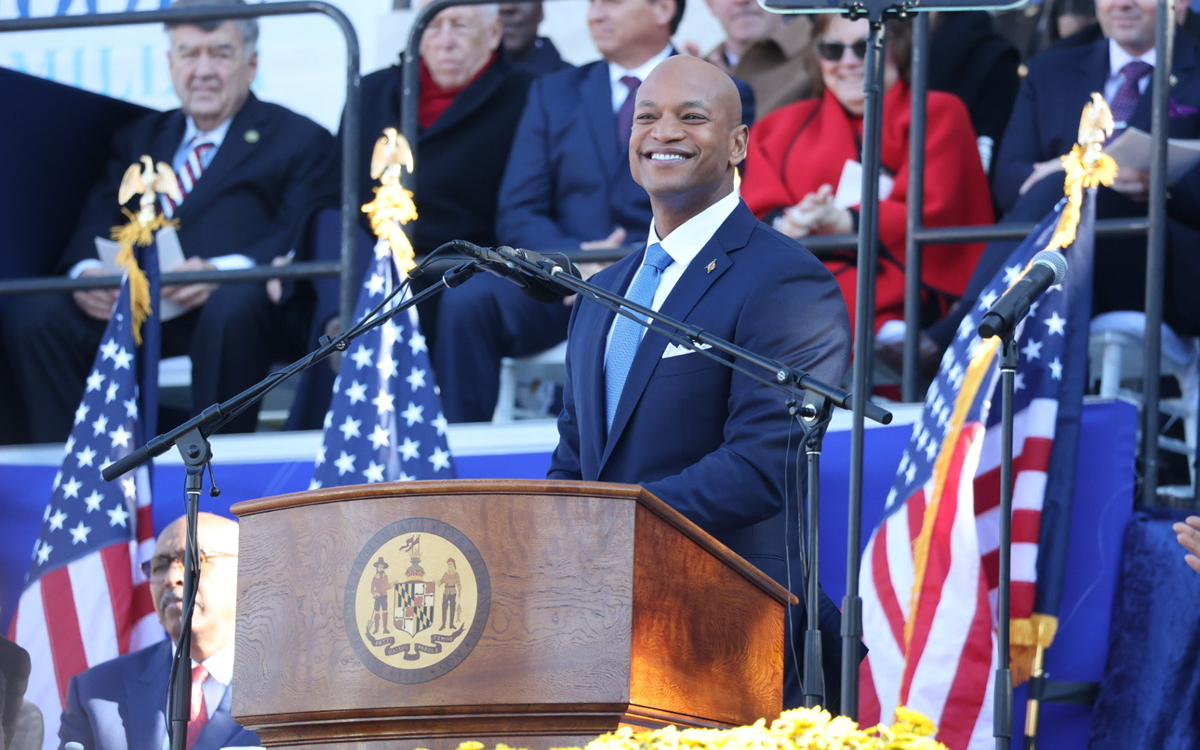
Maryland Gov. Wes Moore on Thursday signed a bill that seeks to combat efforts to ban books from state libraries.
House Bill 785, also known as the Freedom to Read Act, would establish a state policy “that local school systems operate their school library media programs consistent with certain standards; requiring each local school system to develop a policy and procedures to review objections to materials in a school library media program; prohibiting a county board of education from dismissing, demoting, suspending, disciplining, reassigning, transferring, or otherwise retaliating against certain school library media program personnel for performing their job duties consistent with certain standards.”
Moore on Thursday also signed House Bill 1386, which GLSEN notes will “develop guidelines for an anti-bias training program for school employees.”
District of Columbia
Catching up with the asexuals and aromantics of D.C.
Exploring identity and finding community
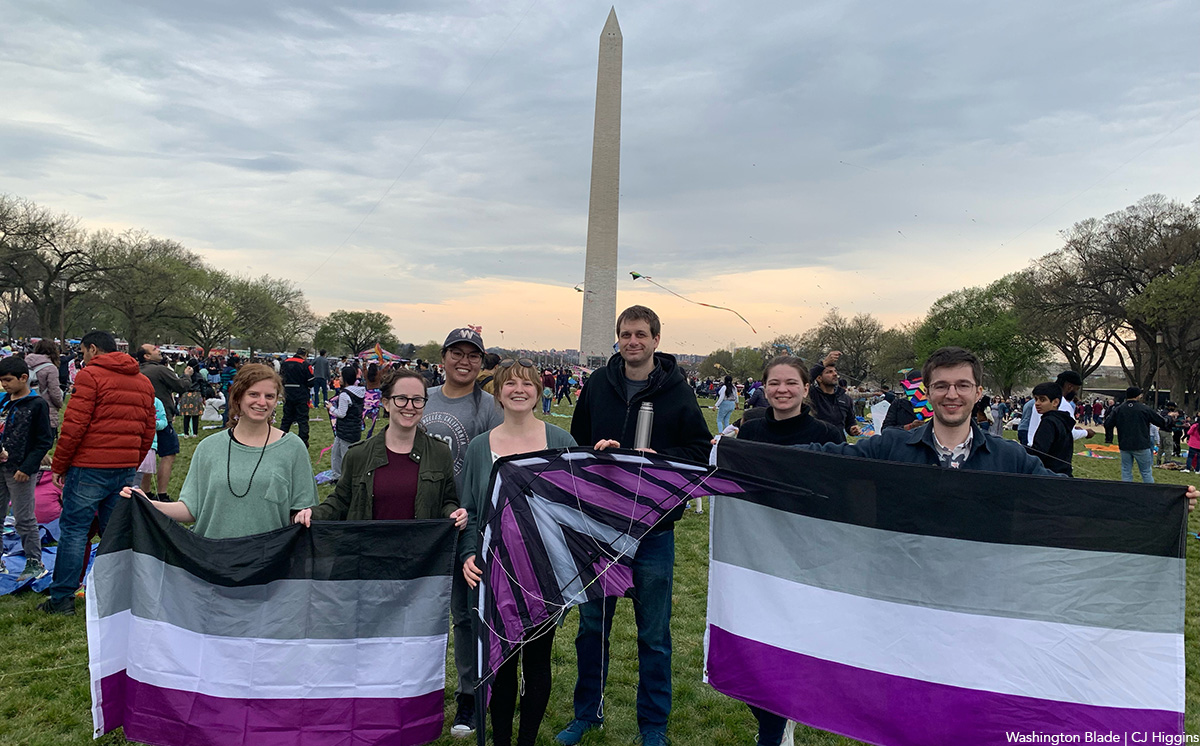
There was enough commotion in the sky at the Blossom Kite Festival that bees might have been pollinating the Washington Monument. I despaired of quickly finding the Asexuals and Aromantics of the Mid-Atlantic—I couldn’t make out a single asexual flag among the kites up above. I thought to myself that if it had been the Homosexuals of the Mid-Atlantic I would’ve had my gaydar to rely on. Was there even such a thing as ace-dar?
As it turned out, the asexual kite the group had meant to fly was a little too pesky to pilot. “Have you ever used a stunt kite?” Bonnie, the event organizer asked me. “I bought one. It looked really cool. But I can’t make it work.” She sighed. “I can’t get the thing six feet off the ground.” The group hardly seemed to care. There was caramel popcorn and cookies, board games and head massages, a game of charades with more than its fair share of Pokémon. The kites up above might as well have been a coincidental sideshow. Nearly two dozen folks filtered in and out of the picnic throughout the course of the day.
But I counted myself lucky that Bonnie picked me out of the crowd. If there’s such a thing as ace-dar, it eludes asexuals too. The online forum for all matters asexual, AVEN, or the Asexual Visibility and Education Network, is filled with laments: “I don’t think it’s possible.” “Dude, I wish I had an ace-dar.” “If it exists, I don’t have it.” “I think this is just like a broken clock is right twice a day type thing.” What seems to be a more common experience is meeting someone you just click with—only to find out later that they’re asexual. A few of the folks I met described how close childhood friends of theirs likewise came out in adulthood, a phenomenon that will be familiar to many queer people. But it is all the more astounding for asexuals to find each other this way, given that asexual people constitute 1.7% of sexual minorities in America, and so merely .1% of the population at large.
To help other asexuals identify you out in the world, some folks wear a black ring on their middle finger, much as an earring on the right ear used to signify homosexuality in a less welcoming era. The only problem? The swinger community—with its definite non-asexuality—has also adopted the signal. “It’s still a thing,” said Emily Karp. “So some people wear their ace rings just to the ace meet-ups.” Karp has been the primary coordinator for the Asexuals and Aromantics of the Mid-Atlantic (AAMA) since 2021, and a member of the meet-up for a decade. She clicked with the group immediately. After showing up for a Fourth of July potluck in the mid-afternoon, she ended up staying past midnight. “We played Cards against Humanity, which was a very, very fun thing to do. It’s funny in a way that’s different than if we were playing with people that weren’t ace. Some of the cards are implying, like, the person would be motivated by sex in a way that’s absurd, because we know they aren’t.”
Where so many social organizations withered during the pandemic, the AAMA flourished. Today, it boasts almost 2,000 members on meetup.com. Karp hypothesized that all the social isolation gave people copious time to reflect on themselves, and that the ease of meeting up online made it convenient as a way for people to explore their sexual identity and find community. Online events continue to make up about a third of the group’s meet-ups. The format allows people to participate who live farther out from D.C. And it allows people to participate at their preferred level of comfort: while many people participate much as they would at an in-person event, some prefer to watch anonymously, video feed off. Others prefer to participate in the chat box, though not in spoken conversation.
A recent online event was organized for a discussion of Rhaina Cohen’s book, “The Other Significant Others,” published in February. Cohen’s book discusses friendship as an alternative model for “significant others,” apart from the romantic model that is presupposed to be both the center and goal of people’s lives. The AAMA group received the book with enthusiasm. “It literally re-wired my brain,” as one person put it. People discussed the importance of friendship to their lives, and their difficulties in a world that de-prioritized friendship. “I can break up with a friend over text, and we don’t owe each other a conversation,” one said. But there was some disagreement when it came to the book’s discussion of romantic relationships. “It relegates ace relationships to the ‘friend’ or ‘platonic’ category, to the normie-reader,” one person wrote in the chat. “Our whole ace point is that we can have equivalent life relationships to allo people, simply without sex.” (“Allo” is shorthand for allosexual or alloromantic, people who do experience sexual or romantic attraction.)
The folks of the AAMA do not share a consensus on the importance of romantic relationships to their lives. Some asexuals identify as aromantic, some don’t. And some aromantics don’t identify as asexual, either. The “Aromantic” in the title of the group is a relatively recent addition. In 2017, the group underwent a number of big changes. The group was marching for the first time in D.C. Pride, participating in the LGBTQ Creating Change conference, and developing a separate advocacy and activism arm. Moreover, the group had become large enough that discussions were opened up into forming separate chapters for D.C., Central Virginia, and Baltimore. During those discussions, the group leadership realized that aromantic people who also identified as allosexual didn’t really have a space to call their own. “We were thinking it would be good to probably change the name of the Meetup group,” Emily said. “But we were not 100% sure. Because [there were] like 1,000 people in the group, and they’re all aces, and it’s like, ‘Do you really want to add a non-ace person?’” The group leadership decided to err on the side of inclusion. “You know, being less gatekeep-y was better. It gave them a place to go — because there was nowhere else to go.”
The DC LGBT Center now sponsors a support group for both asexuals and aromantics, but it was formed just a short while ago, in 2022. The founder of the group originally sought out the center’s bisexual support group, since they didn’t have any resources for ace folks. “The organizer said, you know what, why don’t we just start an ace/aro group? Like, why don’t we just do it?” He laughed. “I was impressed with the turnout, the first call. It’s almost like we tapped into, like, a dam. You poke a hole in the dam, and the water just rushes out.” The group has a great deal of overlap with the AAMA, but it is often a person’s first point of contact with the asexual and aromantic community in D.C., especially since the group focuses on exploring what it means to be asexual. Someone new shows up at almost every meeting. “And I’m so grateful that I did,” one member said. “I kind of showed up and just trauma dumped, and everyone was really supportive.”
Since the ace and aro community is so small, even within the broader queer community, ace and aro folks often go unrecognized. To the chagrin of many, the White House will write up fact sheets about the LGBTQI+ community, which is odd, given that when the “I” is added to the acronym, the “A” is usually added too. OKCupid has 22 genders and 12 orientations on its dating website, but “aromantic” is not one of them — presumably because aromantic people don’t want anything out of dating. And since asexuality and aromanticism are defined by the absence of things, it can seem to others like ace and aro people are ‘missing something.’ One member of the LGBT center support group had an interesting response. “The space is filled by… whatever else!” they said. “We’re not doing a relationship ‘without that thing.’ We’re doing a full scale relationship — as it makes sense to us.”
CJ Higgins is a postdoctoral fellow with the Alexander Grass Humanities Institute at Johns Hopkins University.
District of Columbia
Bowser budget proposal calls for $5.25 million for 2025 World Pride
AIDS office among agencies facing cuts due to revenue shortfall
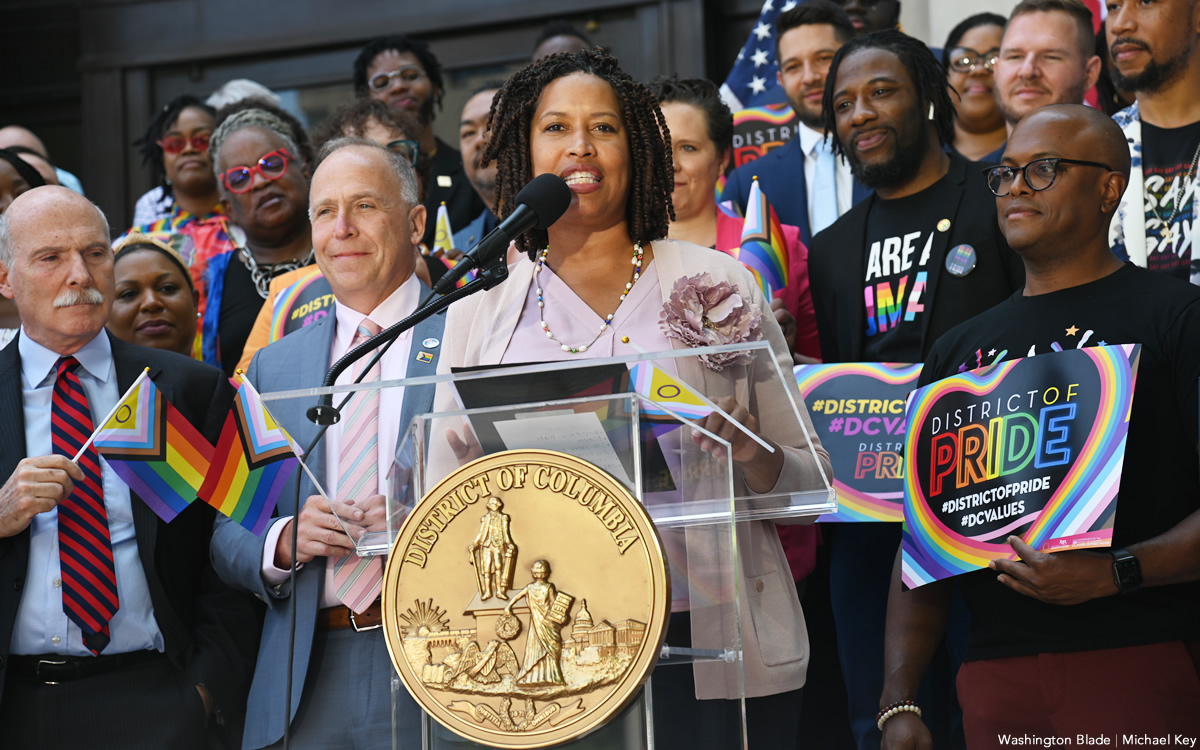
D.C. Mayor Muriel Bowser’s proposed fiscal year 2025 budget includes a request for $5.25 million in funding to support the June 2025 World Pride celebration, which D.C. will host, and which is expected to bring three million or more visitors to the city.
The mayor’s proposed budget, which she presented to the D.C. Council for approval earlier this month, also calls for a 7.6 percent increase in funding for the Mayor’s Office of LGBTQ Affairs, which amounts to an increase of $132,000 and would bring the office’s total funding to $1.7 million. The office, among other things, provides grants to local organizations that provide services to the LGBTQ community.
Among the other LGBTQ-related funding requests in the mayor’s proposed budget is a call to continue the annual funding of $600,000 to provide workforce development services for transgender and gender non-conforming city residents “experiencing homelessness and housing instability.” The budget proposal also calls for a separate allocation of $600,000 in new funding to support a new Advanced Technical Center at the Whitman-Walker Health’s Max Robinson Center in Ward 8.
Among the city agencies facing funding cuts under the mayor’s proposed budget is the HIV/AIDS, Hepatitis, Sexually Transmitted Disease, and Tuberculosis Administration, known as HAHSTA, which is an arm of the D.C. Department of Health. LGBTQ and AIDS activists have said HAHSTA plays an important role in the city’s HIV prevention and support services. Observers familiar with the agency have said it recently lost federal funding, which the city would have to decide whether to replace.
“We weren’t able to cover the loss of federal funds for HAHSTA with local funds,” Japer Bowles, director of the Mayor’s Office of LGBTQ Affairs, told the Washington Blade. “But we are working with partners to identify resources to fill those funding gaps,” Bowles said.
The total proposed budget of $21 billion that Bowser submitted to the D.C. Council includes about $500 million in proposed cuts in various city programs that the mayor said was needed to offset a projected $700 million loss in revenue due, among other things, to an end in pandemic era federal funding and commercial office vacancies also brought about by the post pandemic commercial property and office changes.
Bowser’s budget proposal also includes some tax increases limited to sales and business-related taxes, including an additional fee on hotel bookings to offset the expected revenue losses. The mayor said she chose not to propose an increase in income tax or property taxes.
Earlier this year, the D.C. LGBTQ+ Budget Coalition, which consists of several local LGBTQ advocacy organizations, submitted its own fiscal year 2025 budget proposal to both Bowser and the D.C. Council. In a 14-page letter the coalition outlined in detail a wide range of funding proposals, including housing support for LGBTQ youth and LGBTQ seniors; support for LGBTQ youth homeless services; workforce and employment services for transgender and gender non-conforming residents; and harm reduction centers to address the rise in drug overdose deaths.
Another one of the coalition’s proposals is $1.5 million in city funding for the completion of the D.C. Center for the LGBTQ Community’s new building, a former warehouse building in the city’s Shaw neighborhood that is undergoing a build out and renovation to accommodate the LGBTQ Center’s plans to move in later this year. The coalition’s budget proposal also calls for an additional $300,000 in “recurring” city funding for the LGBTQ Center in subsequent years “to support ongoing operational costs and programmatic initiatives.”
Bowles noted that Bowser authorized and approved a $1 million grant for the LGBTQ Center’s new building last year but was unable to provide additional funding requested by the budget coalition for the LGBTQ Center for fiscal year 2025.
“We’re still in this with them,” Bowles said. “We’re still looking and working with them to identify funding.”
The total amount of funding that the LGBTQ+ Budget Coalition listed in its letter to the mayor and Council associated with its requests for specific LGBTQ programs comes to $43.1 million.
Heidi Ellis, who serves as coordinator of the coalition, said the coalition succeeded in getting some of its proposals included in the mayor’s budget but couldn’t immediately provide specific amounts.
“There are a couple of areas I would argue we had wins,” Ellis told the Blade. “We were able to maintain funding across different housing services, specifically around youth services that affect folks like SMYAL and Wanda Alston.” She was referring to the LGBTQ youth services group SMYAL and the LGBTQ organization Wanda Alston Foundation, which provides housing for homeless LGBTQ youth.
“We were also able to secure funding for the transgender, gender non-conforming workforce program,” she said. “We also had funding for migrant services that we’ve been advocating for and some wins on language access,” said Ellis, referring to programs assisting LGBTQ people and others who are immigrants and aren’t fluent in speaking English.
Ellis said that although the coalition’s letter sent to the mayor and Council had funding proposals that totaled $43.1 million, she said the coalition used those numbers as examples for programs and policies that it believes would be highly beneficial to those in the LGBTQ community in need.
“I would say to distill it down to just we ask for $43 million or whatever, that’s not an accurate picture of what we’re asking for,” she said. “We’re asking for major investments around a few areas – housing, healthcare, language access. And for capital investments to make sure the D.C. Center can open,” she said. “It’s not like a narrative about the dollar amounts. It’s more like where we’re trying to go.”
The Blade couldn’t’ immediately determine how much of the coalition’s funding proposals are included in the Bowser budget. The mayor’s press secretary, Daniel Gleick, told the Blade in an email that those funding levels may not have been determined by city agencies.
“As for specific funding levels for programs that may impact the LGBTQ community, such as individual health programs through the Department of Health, it is too soon in the budget process to determine potential adjustments on individual programs run though city agencies,” Gleick said.
But Bowles said several of the programs funded in the mayor’s budget proposal that are not LGBTQ specific will be supportive of LGBTQ programs. Among them, he said, is the budget’s proposal for an increase of $350,000 in funding for senior villages operated by local nonprofit organizations that help support seniors. Asked if that type of program could help LGBTQ seniors, Bowles said, “Absolutely – that’s definitely a vehicle for LGBTQ senior services.”
He said among the programs the increased funding for the mayor’s LGBTQ Affairs office will support is its ongoing cultural competency training for D.C. government employees. He said he and other office staff members conduct the trainings about LGBTQ-related issues at city departments and agencies.
Bowser herself suggested during an April 19 press conference that local businesses, including LGBTQ businesses and organizations, could benefit from a newly launched city “Pop-Up Permit Program” that greatly shortens the time it takes to open a business in vacant storefront buildings in the downtown area.
Bowser and Nina Albert, D.C. Deputy Mayor for Planning and Economic Development, suggested the new expedited city program for approving permits to open shops and small businesses in vacant storefront spaces could come into play next year when D.C. hosts World Pride, one of the word’s largest LGBTQ events.
“While we know that all special events are important, there is an especially big one coming to Washington, D.C. next year,” Bowser said at the press conference. “And to that point, we proposed a $5.25 million investment to support World Pride 2025,” she said, adding, “It’s going to be pretty great. And so, we’re already thinking about how we can include D.C. entrepreneurs, how we’re going to include artists, how we’re going to celebrate across all eight wards of our city as well,” she said.
Among those attending the press conference were officials of D.C.’s Capital Pride Alliance, which will play a lead role in organizing World Pride 2025 events.
-

 State Department4 days ago
State Department4 days agoState Department releases annual human rights report
-

 District of Columbia2 days ago
District of Columbia2 days agoCatching up with the asexuals and aromantics of D.C.
-

 South America2 days ago
South America2 days agoArgentina government dismisses transgender public sector employees
-

 Maine3 days ago
Maine3 days agoMaine governor signs transgender, abortion sanctuary bill into law

